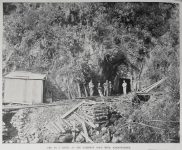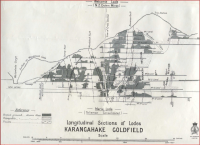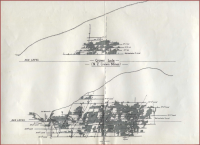New Talisman Gold Mines Limited hold Mining Permit No 51326 which amalgamates the historical mining licence areas of the Talisman Gold Mine and New Zealand Crown Mines in Karangahake, North Island, New Zealand.
Historical Perspective
Alluvial gold was first discovered in New Zealand near Coromandel in 1852 and the Ohinimuri gold field was officially opened up to prospectors on 3 March 1875. Initially at least 600 claims were pegged on Karangahake Mountain, however the alluvial deposit proved smaller than anticipated and gold was difficult to extract from the reefs using mercury amalgam. The majority of prospectors left within two months. It was not until seven years later that extensive prospecting revealed gold bearing reefs outcropping on the mountainside, particularly the Maria reef which was discovered in March 1882.
The Talisman Mine
The Talisman Gold Mining Company was registered in November 1894 and marked the beginning of large scale mining operations in Karangahake. As the mine grew the company assimilated several other claims and by 1905, the Talisman had expanded from the original 30 acres to 506 acres by taking over the Bonanza claim (1896), the Talisman Extended, Royal Mail, Victor-Waihou, and finally, Woodstock in 1904.

Initially all mining on the Maria Reef was carried out on the upper levels of the Karangahake Mountain and accessed by means of adits. In 1900 a shaft was sunk from No 8 Level and reached a depth of 1,000 ft. Lower levels were driven from the shaft and also from the Woodstock mine which had been taken over in 1904. Access to Talisman 14 Level could then be achieved via the Woodstock shaft. 15 and 16 Levels were reached by ladder from 14 Level. Ore from these levels was hoisted through the Talisman Shaft.
Levels at Talisman were established at 200 foot intervals with intermediate levels being established as required.

Between 1906 and 1914, extensive mining was carried out between No. 8 and No. 13 levels. Production climbed steadily from 4,194 tons in 1898 to 13,396 tons in 1902 then jumped to 47,267 tons in 1903. The peak was reached in 1914 with 52,210 tons of ore mined. From that point the scale of operations declined and at the end of December 1919 operations ceased. In 1920 the company went into liquidation. During its lifetime the company produced most of the 3,510,691 oz. of bullion which came from the claim with bullion was valued at £2,958,013 and had paid £1,150,972 in dividends.
Crown Mine
This claim was situated on both sides of the Waitawheta River upstream of the Talisman claim. The Waitawheta Gorge formed a natural “crosscut” through the reefs on the claim allowing both the Welcome and Crown veins to be mined on the north and south sides of the river, although operations were focussed on the south side under the Karangahake Mountain.
Mining of the Crown claim began in 1883 but initial progress was slow due to difficulties in treating the ore. The uppermost level mined was the 5A Level which is on the same elevation as the Talisman 8 Level

The lowest level being mined in 1887 was some 500 feet above the river and an inclined tramway was constructed to bring ore down to the battery. Early work had all been on the Crown Reef but in 1891 work commenced on the Welcome Reef through a new level driven just above river level which extended 2894 feet into the mountainside.
In 1896 a shaft was sunk from a chamber excavated in the river level in order to replace ore in the upper levels which were becoming depleted. This shaft eventually reached a depth of 526 feet and 5 levels were established from it. Water handling below river level was a continuous battle at Crown with installed pumping capacity reaching 91,000 gallons an hour in 1910 following complete flooding of the lower levels
The only recorded occurrence of hydrogen sulphide gas in the area was through a winze being sunk from 5B level. Over the years, the area held had increased from 60 acres to 404 acres. The claims taken over by the Crown Company included Monastery, Earl of Glasgow (Maria Reef), Mammoth, Ravenswood.
Profitability declined during the period 1910/15 and by 1916 the mine was being worked entirely by tributers. Maintenance of the water races and levels continued up until 1919 but in 1920 the machinery was dismantled. Very small scale mining was carried out up until July 1928 when the company relinquished its holdings.
Talisman Dubbo Gold Mining Company
During the peak years, the Maria Reef had been extensively worked by the Talisman from near the summit of Mt Karangahake to over 500 feet below sea level. Part of this reef, however, had not been worked because it lay within the area held by the N.Z. Crown Mines which had not exploited it because of the distance from their main workings on the Welcome and Crown Reefs.
The unworked portion of the Maria Reef lay in the area earlier known as the Earl of Glasgow claim and favourable prospecting results were obtained in 1928. This was followed by the formation of the Talisman Dubbo Co which was registered in December 1929. Driving on the Maria vein from the southern side of the mountain commenced and November 1930 had been extended 450 feet. Two tonnes of ore had undergone metallurgical testing and the company had a stockpile of over 100 tons.
In 1930, attempts were made to reopen the old Talisman No 1 Level which entered from the N.W. face of the mountain, 115 feet below the Talisman Dubbo drive. In order to create a tramming level to the more accessible North West mountain face. These attempts failed and a new level was driven alongside.
Stoping operations and ore treatment were underway in 1932 and an aerial tramway, transporting ore to the Talisman 8 Level, was commissioned in 1933. The mine operated profitably until 1938, operations were downsized in 1939 and eventually closed in 1940.
The company’s business was finalised by 1941 and all mining privileges had been struck off the register.
